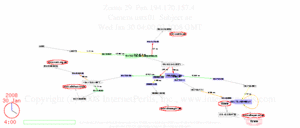 Per Hansen of Ciena at
NANOG 50
talked about
growing capacity not by adding more
data cables under the sea, rather by increasing spectral density.
Eventually new cables will be needed, but meanwhile he thinks
we can get up from about 2 bits to to 5 or 6 bits per Hertz.
It does require more power: same energy per bit, but more bits.
Per Hansen of Ciena at
NANOG 50
talked about
growing capacity not by adding more
data cables under the sea, rather by increasing spectral density.
Eventually new cables will be needed, but meanwhile he thinks
we can get up from about 2 bits to to 5 or 6 bits per Hertz.
It does require more power: same energy per bit, but more bits.
 Plus mesh networks for rerouting, even if it means rerouting
backwards around the world, he notes.
We’ve observed that sort of emergency backwards routing
as long ago as January 2008, in the
U.A.E. Cable Cut.
Plus mesh networks for rerouting, even if it means rerouting
backwards around the world, he notes.
We’ve observed that sort of emergency backwards routing
as long ago as January 2008, in the
U.A.E. Cable Cut.
-jsq
